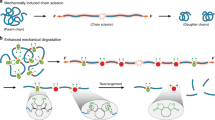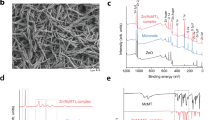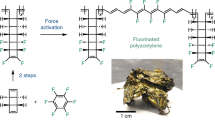Abstract
Homogeneously catalysed reactions can be ‘switched on’ by activating latent catalysts. Usually, activation is brought about by heat or an external chemical agent. However, activation of homogeneous catalysts with a mechanical trigger has not been demonstrated. Here, we introduce a general method to activate latent catalysts by mechanically breaking bonds between a metal and one of its ligands. We have found that silver(i) complexes of polymer-functionalized N-heterocyclic carbenes, which are latent organocatalysts, catalyse a transesterification reaction when exposed to ultrasound in solution. Furthermore, ultrasonic activation of a ruthenium biscarbene complex with appended polymer chains results in catalysis of olefin metathesis reactions. In each case, the catalytic activity results from ligand dissociation, brought about by transfer of mechanical forces from the polymeric substituents to the coordination bond. Mechanochemical catalyst activation has potential applications in transduction and amplification of mechanical signals, and mechanically initiated polymerizations hold promise as a novel repair mechanism in self-healing materials.
This is a preview of subscription content, access via your institution
Access options
Subscribe to this journal
Receive 12 print issues and online access
$259.00 per year
only $21.58 per issue
Buy this article
- Purchase on Springer Link
- Instant access to full article PDF
Prices may be subject to local taxes which are calculated during checkout





Similar content being viewed by others
References
Sinn, H., Kaminsky, W., Vollmer, H. J. & Woldt R. Living polymers on polymerization with extremely productive Ziegler catalysts. Angew. Chem. Int. Ed. 19, 390–392 (1980).
Slugovc, C., Burtscher, D., Stelzer, F. & Mereiter K. Thermally switchable olefin metathesis initiators bearing chelating carbenes: Influence of the chelate's ring size. Organometallics 24, 2255–2258 (2005).
Slaugh, L. H. & Mullineaux, R. D. Novel hydroformylation catalysts. J. Organomet. Chem. 13, 469–477 (1968).
Sentman, A. C., Csihony, S., Waymouth, R. M. & Hedrick, J. L. Silver(i)–carbene complexes/ionic liquids: Novel N-heterocyclic carbene delivery agents for organocatalytic transformations. J. Org. Chem. 70, 2391–2393 (2005).
Gawin, R., Makal, A., Wozniak, K., Mauduit, M. & Grela, K. A dormant ruthenium catalyst bearing a chelating carboxylate ligand: In situ activation and application in metathesis reactions. Angew. Chem. Int. Ed. 46, 7206–7209 (2007).
Beyer, M. K. & Clausen-Schaumann, H. Mechanochemistry: The mechanical activation of covalent bonds. Chem. Rev. 105, 2921–2948 (2005).
Hickenboth, C. R. et al. Biasing reaction pathways with mechanical force. Nature 446, 423–427 (2007).
Nguyen, T. Q. & Kausch, H.-H. Mechanochemical degradation in transient elongational flow. Adv. Polym. Sci. 100, 73–182 (1992).
Basedow, A. M. & Ebert, K. H. Ultrasonic degradation of polymer in solution. Adv. Polym. Sci. 22, 83–148 (1977).
Encina, M. V., Lissi, E., Sarasua, M., Gargallo, L. & Radic, D. Ultrasonic degradation of polyvinylpyrrolidone—Effect of peroxide linkages. J. Polym. Sci., Polym. Lett. Ed. 18, 757–760 (1980).
Berkowski, K. L., Potisek, S. L., Hickenboth, C. R. & Moore, J. S. Ultrasound-induced site-specific cleavage of azo-functionalized poly(ethylene glycol). Macromolecules 38, 8975–8978 (2005).
Paulusse, J. M. J. & Sijbesma, R. P. Reversible mechanochemistry of a Pd-ii coordination polymer. Angew. Chem. Int. Ed. 43, 4460–4462 (2004).
Karthikeyan, S., Potisek, S. L., Piermattei, A. & Sijbesma, R. P. Highly efficient mechanochemical scission of silver–carbene coordination polymers. J. Am. Chem. Soc. 130, 14968–14969 (2008).
Marion, N., Diez-Gonzalez, S. & Nolan, S. P. N-heterocyclic carbenes as organocatalysts. Angew. Chem. Int. Ed. 46, 2988–3000 (2007).
Grasa, G. A., Kissling, R. M. & Nolan, S. P. N-hetercocyclic carbenes as versatile nucleophilic catalysts for transesterification/acylation reactions. Org. Lett. 4, 3583–3586 (2002).
Trnka, T. M. & Grubbs, R. H. The development of L2X2Ru=CHR olefin metathesis catalysts: An organometallic success story. Acc. Chem. Res. 34, 18–29 (2001).
Ledoux, N., Allaert, B., Linden, A., Van der Voort, P. & Verpoort, F. Bis-coordination of N-(alkyl)-N′-(2,6-diisopropylphenyl) heterocyclic carbenes to Grubbs catalysts. Organometallics 26, 1052–1056 (2007).
Dubreuil, M. F., Farcy, N. G. & Goethals, E. J. Influence of the alkyl group of triflate esters on their initiation ability for the cationic ring-opening polymerization of tetrahydrofuran. Macromol. Rapid Commun. 20, 383–386 (1999).
Ritter, T., Hejl, A., Wenzel, A. G., Funk, T. W. & Grubbs, R. H. A standard system of characterization for olefin metathesis catalysts. Organometallics 25, 5740–5745 (2006).
Dias, E. L., Nguyen, S. T. & Grubbs, R. H. Well-defined ruthenium olefin metathesis catalysts: Mechanism and activity. J. Am. Chem. Soc. 119, 3887–3897 (1997).
Sanford, M. S., Love, J. A. & Grubbs, R. H. Mechanism and activity of ruthenium olefin metathesis catalysts. J. Am. Chem. Soc. 123, 6543–6554 (2001).
van der Zwaag, S., Schmets, A. J. M. & van der Zaken, G. (eds) Self Healing Materials (Springer, 2007).
Acknowledgements
This work was supported by grants from the Netherlands Organization for Scientific Research (NWO). We thank R.T.M. Jakobs for help with the synthesis of compounds 6 and 7.
Author information
Authors and Affiliations
Contributions
R.P.S. conceived the sonochemical catalyst activation experiment and directed the research. A.P. and S.K. performed the experiments. All of the authors participated in writing the paper.
Corresponding author
Supplementary information
Supplementary information
Supplementary information (PDF 1727 kb)
Rights and permissions
About this article
Cite this article
Piermattei, A., Karthikeyan, S. & Sijbesma, R. Activating catalysts with mechanical force. Nature Chem 1, 133–137 (2009). https://doi.org/10.1038/nchem.167
Received:
Accepted:
Published:
Issue Date:
DOI: https://doi.org/10.1038/nchem.167
This article is cited by
-
Switchable aqueous catalytic systems for organic transformations
Communications Chemistry (2022)
-
The many flavours of mechanochemistry and its plausible conceptual underpinnings
Nature Reviews Chemistry (2021)
-
Mechanochemical bond scission for the activation of drugs
Nature Chemistry (2021)
-
Crystallization-induced mechanofluorescence for visualization of polymer crystallization
Nature Communications (2021)
-
Reversible Mechanochemistry Enabled Autonomous Sustaining of Robustness of Polymers—An Example of Next Generation Self-healing Strategy
Chinese Journal of Polymer Science (2021)



